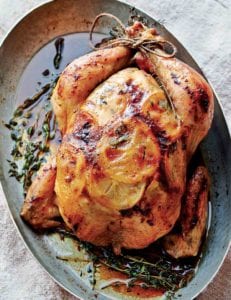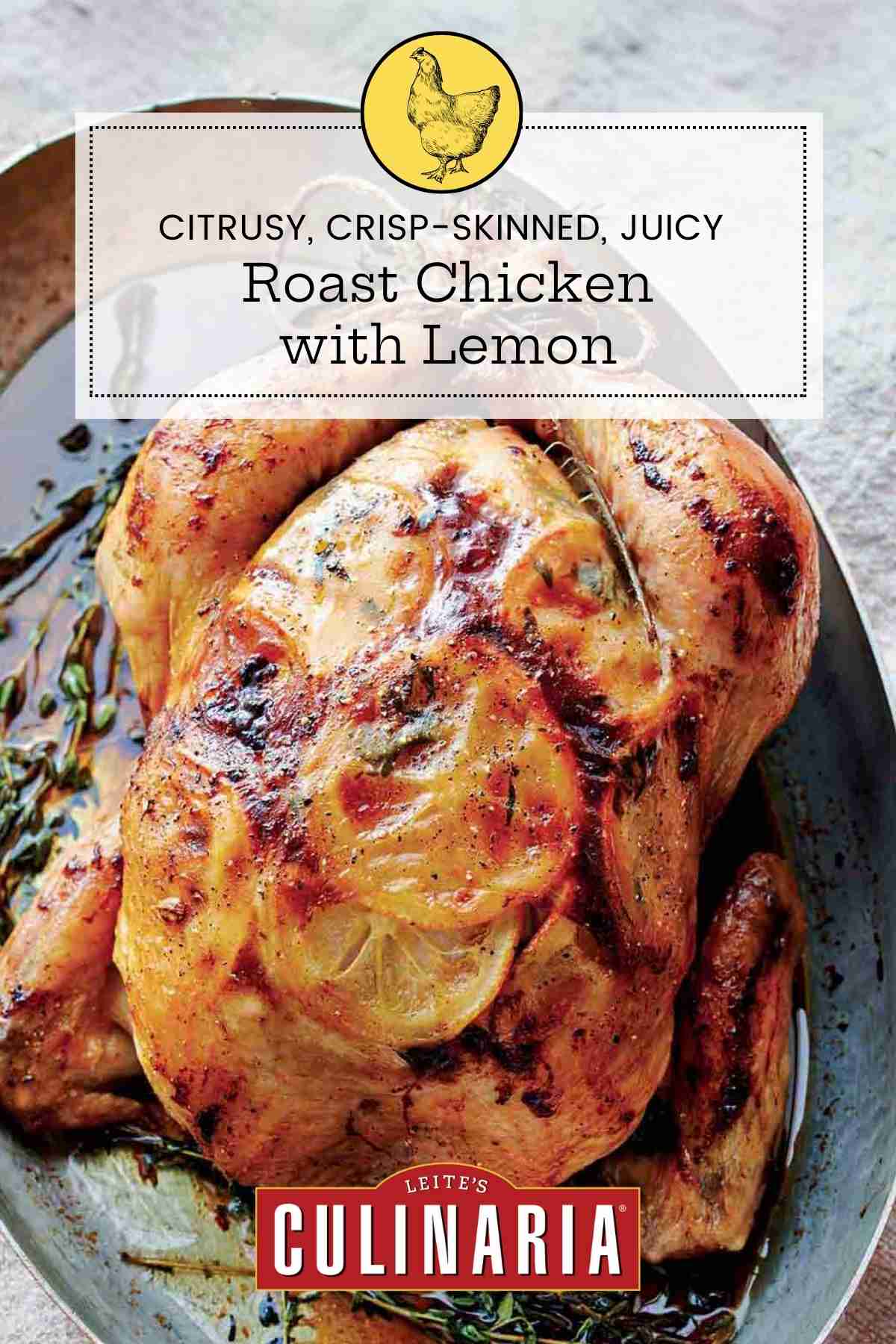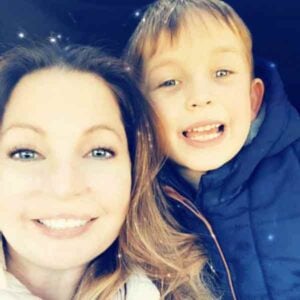
Is anything more homey or more knee-wobblingly satisfying than crisp-skinned chicken roasted with vegetables to soak up the pan juices? Sounds like Sunday supper to us. Sounds like supper any day of the week, actually.–Renee Schettler
Roast Chicken with Lemon FAQs
A dry brine simply involves rubbing your bird down with salt and letting it sit for several hours or overnight in the refrigerator. The salt helps to draw out some moisture from the skin, resulting in extra-crispy skin once the chicken is cooked.
We wouldn’t say no to mashed potatoes in any form alongside this roast chicken, and a simple side salad or some braised saffron carrots would round out the meal nicely.

Roast Chicken with Lemon
Ingredients
For the dry brine*
- One (3- to 5-pound) whole chicken
- 2 tablespoons kosher salt, plus more to taste
For the herb butter
- 4 tablespoons (2 oz) unsalted butter, at room temperature
- 2 teaspoons fresh lemon thyme or regular thyme, minced, plus 2 to 4 sprigs for the gravy
For the roast chicken
- 8 thin lemon slices, (from about 1/2 lemon)
- 1 tablespoon extra-virgin olive oil
- 1/2 teaspoon freshly ground black pepper, plus more to taste
For the pan gravy
- About 2 cups homemade chicken stock or canned chicken broth
- 2 tablespoons all-purpose flour or 1 tablespoon cornstarch
- 1/4 cup heavy cream
Instructions
Dry brine the chicken
- Pat the chicken dry and sprinkle it inside and out with the salt. Slide it inside a large resealable plastic bag and refrigerate for at least 16 hours and up to 48 hours.
- Remove the chicken from the refrigerator 1 hour before roasting and place it on the counter.
Preheat the oven
- Preheat the oven to 425°F (220°C).
Mix the herb butter
- In a bowl, mix together the butter and minced thyme.
Prepare the chicken
- Rinse the chicken inside and out under cold running water and pat the chicken very, very dry. Starting at the cavity, gently slip your fingers underneath the chicken skin and loosen it all over, reaching as far as possible into the thigh and breast area and being careful not to tear it.
- Using your fingers, massage the herb butter under the skin to distribute it as evenly as possible. Slip the lemon slices under the breast skin, arranging 4 slices on each side. (If you have a small bird and the slices don’t all fit, overlap them or simply tuck the extra lemon in the cavity.) Rub the chicken all over with the oil and season with the 1/2 teaspoon pepper. Bend the wing tips and tuck them under the shoulders. Don’t truss the chicken.
Roast the chicken
- Place a large, heavy, ovenproof skillet (preferably cast iron) in the oven and heat until very hot, about 5 minutes. Twist a 12-inch (30-centimeter) length of aluminum foil into a rope and fashion it into a ring. Remove the pan from the oven and carefully place the ring in the pan. Place the chicken, breast side up, on the ring.
- Return the skillet to the oven and roast, basting occasionally with the fat in the pan, until an instant-read thermometer inserted into the thickest part of the thigh away from the bone registers 165°F (74°C), anywhere from 45 to 80 minutes, depending on the size of the bird.
Rest the bird
- Place the chicken on a rimmed platter and let stand for at least 15 minutes before carving.
Make the pan gravy
- While the chicken rests, remove and discard the foil ring from the skillet. Pour the pan drippings into a large heatproof liquid measuring cup. Let stand for a few minutes, then spoon off and reserve the fat floating on the surface of the drippings. Add enough stock to the drippings left in the cup to total 2 cups (16 ounces) liquid.
- Place the skillet over medium heat. Add 2 tablespoons reserved fat to the skillet and whisk in the flour or cornstarch, stirring until a thick paste forms. Let the mixture bubble for 1 minute. Gradually whisk in the stock mixture and the cream and bring to a boil. Reduce the heat to low and simmer, whisking frequently, until thickened, about 3 minutes. Remove from the heat, season with salt and pepper, and add the thyme sprigs, if using.
Carve, serve, enjoy
- Carve the chicken, pile it onto a platter, and pass the gravy on the side.
Explore More with AI
Nutrition
Nutrition information is automatically calculated, so should only be used as an approximation.
Recipe Testers’ Reviews
It felt like a special occasion when I served this beautiful roast chicken with lemon. The thyme and gravy make it a great dish to serve to guests…but I didn’t. My chicken was only 3 1/2 pounds, so my husband and I enjoyed it as a special weeknight meal.
I like the idea that I could dry brine it the night before. (I left it in the fridge for 30 hours!) Massaging the butter mixture under the skin worked well. My little chicken still took 1 hour and 10 minutes. For the gravy, I didn’t get 2 cups liquid but also knew I wouldn’t need that much for just the two of us, so I reduced the liquid to 1 cup. It was all very tasty!
This roast chicken with lemon taught me two new delicious techniques, so in my book, that already makes it a winner. I love the idea of brining, but I hate the fuss of liquid brines or even dry brines with a ton of ingredients. Plus, as a single working mom, I just don’t have the time. But slap a few tablespoons of salt on a bird and toss it in the fridge for the day? I can do that! Simple? Check. Relatively little hands-on time? Check. Delicious? Check. Loved it!
I placed the salted bird on a plate in the kitchen and drained it twice over an 8-hour period. Then I let it rest at room temperature for 1 hour before rinsing and preparing it for the oven. Because I used a 4 1/2-pound organic roasting chicken, I was only able to fit 2 slices lemon per side. The hen was cooked perfectly after 1 hour, 10 minutes. I had 1/4 cup juices in the pan after skimming the fat, so I added about 1 1/2 cups chicken broth to the pan. I only used 2 tablespoons flour and omitted the cream. The gravy was still thick and full-bodied, possessing a wonderful flavor without adding any additional seasoning (minus the thyme sprigs).
This roast chicken with lemon definitely fits the description of a TC for me: easy, delicious, beautiful right out of the oven, and going into the family favorites notebook! Just the right amount of lemon-thyme flavor comes through, both in the chicken and the gravy. The skin is beautifully colored and crisp with slightly salty and lemony overtones. You will want to sing after the first taste!
I used a 3 3/4-pound chicken and refrigerated it for 21 hours. It roasted for approximately 55 minutes until it registered 170°F on the thermometer. I had to add chicken stock to the pan drippings to get 2 cups liquid, as there was only about 1/4 to 1/3 cup pan juices after skimming the fat. I served this lovely chicken with jasmine rice and steamed sliced carrots. A beautiful plate and 2 happy tasters. A+.
I chose a 3-pound bird and used half the amount of salt, since my chicken was just half the size called for in the recipe. I usually don’t like to brine my poultry too long, as it can end up tasting like deli meat, especially with a wet brine. I dry brined mine before I went to bed the night before, which resulted in 20 hours of brine time. This resulted in tender and moist white meat, although it was a tad salty for me, even after the rinse and pat. I would try the recipe again, brining for 14 hours and rubbing with salt that morning.
Despite using a smaller bird, I went for the full amount of thyme butter and lemon slices. I had quite a bit of trouble spreading the butter under the skin and found it nearly impossible to loosen the skin surrounding the dark meat. In the end, I got the butter under the breast skin and just spread it on top of the skin of the dark meat. The result was flavorful, moist, and crisp. I removed the butter from the fridge at the time I removed the bird. I set out my chicken and butter for 1 hour. The chicken was still chilled, and the butter was soft but would’ve been easier to work with if it had had another hour at room temperature.
I loved getting to take advantage of my collection of cast-iron pans by preheating a large one for 5 minutes. The sizzle when the edges of the bird hit the hot cast-iron made me that much more excited to dig into what I found to be a crisp and tender roast. My bird cooked in just 35 minutes! I’d expected 45 to 50 minutes, since the suggested time for a bird twice the size was 1 hour, 20 minutes. But the meat was cooked perfectly! It was extra juicy.
I got very few drippings, and there was mostly fat in the pan—about 2 tablespoons. Some juices rendered as the chicken rested, but I had to use stock I already had on hand to make the gravy. I made a 5-minute roux with the flour and fat, as 1 minute is quite short, and I’m very turned off by raw flour taste. I also whisked and simmered the gravy an extra 5 minutes or so since my reserved stock was cold, and gravy should be piping hot.
The gravy was incredible! I would’ve put the thyme sprigs in at the beginning to let the flavor infuse the gravy even more. I served this perfect roast chicken with white rice, roasted Brussels sprouts, and celeriac, as well as a salad lightly dressed with lemon and olive oil.
This was a terrific roast chicken with lemon recipe. The best I’ve ever had? Probably not. But it was really, really good. The lemon flavor was perfect—pronounced but not overwhelming. I did have a little trouble getting the butter under the skin without tearing it. I was able to rub the butter in and fit 5 lemon slices in the chicken. I have small hands, but there was no hope of really getting into the thigh area either.
My chicken was 3 pounds and took 45 minutes to roast. I’ve roasted a lot of chickens, so I had a pretty good idea that 45 minutes would be perfect. The foil ring seemed to provide a bit of support for the chicken. My chicken yielded very little drippings; there was really only enough fat to make the roux, and I had to add stock to it.














Honestly, I procrastinated so badly that I didn’t even do the dry brine. I just changed it out for salted butter. The meat was lightly seasoned and balanced the gravy really well. It’s a little tricky getting under the skin of the bird, but after that, the rest is easy! I was a little concerned that the skin would burn at that temperature, but it crisped up nicely and was dark in a few places but not burnt. The meat was juicy all the way through (even in the typically dry breast).
When making the gravy, I used the baster to suck the drippings out from under the fat rather than waiting and skimming the fat off the top. One lemon, cut into roughly 1/8-inch-thick slices, gave me 8 slices and 2 ends. Having no other use for the ends, I tucked them and a few sprigs thyme into the cavity of the bird. My chicken was 5 1/2 pounds. I roasted it for 1 hour and 10 minutes, but I really felt that it could’ve done with an extra 10 minutes. I was a little concerned that I wasn’t getting under the skin right because I kept running into barriers, as I passed this muscle and that one, but I kept pushing through. Getting the butter in was easy after I realized I needed to to remove my rings or risk losing them in the bird. I had about 1/2 tablespoon left over, so I wiped it on the underside of the breast in the cavity, then smeared the outside with the remaining butter on my hands. I omitted the olive oil, since the bird was now coated in butter, and EVOO doesn’t bake well.
The four slices of lemon needed to overlap in order to fit, and one of them pretty much sat in the bend between the thigh and the breast. I might, in the future, intentionally stick one at each of the thighs, and only use 3 on the breasts. I imagine this would also be the case for smaller birds. I had maybe 1/2 cup drippings from the bird. Had a hard time skimming the fat and decided to use the baster to suck it out from underneath. I added some unseasoned bone broth, a few hearty pinches of salt, a few grinds of pepper, and a sprig of thyme.
The gravy came out thinner than I’m used to, and I was concerned that it wouldn’t set, but it ended up being fine. It’s more like a sauce than a gravy, which was actually just right for the chicken, so there go my preconceptions about how thick a chicken gravy ought to be.
Wow, Elizabeth thank you for this!